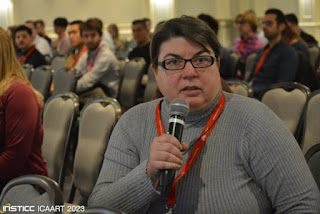After an extensive journey of in-depth exploration, spanning literature review, hypothesis formulation, modeling, implementation, and many weeks of simulation, Kristina Wogatai proudly presented her paper, "A Graph-Based Approach for Applying Biologically-Inspired Slime Mold Algorithms for Repairing a Power Transmission Network after an Electromagnetic Pulse Attack," at the 2nd International Conference on Power Systems and Electrical Technology (PSET) in Milan, Italy, held from August 25th to 27th, 2023. The paper, authored by Kristina Wogatai, Johannes Winkler, and Wilfried Elmenreich, explores how to apply slime mold algorithms to restore power grids after an electromagnetic pulse (EMP) attack.
Our proposed method intricately utilized a simulated slime mold algorithm on graph models to pinpoint critical repair areas, drawing inspiration from how slime molds construct networks between food sources. These single-celled organisms, known for their intelligent swarm behavior, have inspired algorithms addressing optimization problems and the creation of efficient transportation networks. Our open-source algorithm, SISMO (Simulation of Slime Molds), has contributed to this work.
Adapting the SISMO algorithm for connecting power stations and plants required overcoming challenges, such as incorporating geographic or demographic criteria for power line placement. Initially provided only with the positions of power stations, we addressed this problem by leveraging graph visualization algorithms like Force Atlas, Force Atlas2, and Yifan-Hu to modify the layout and thus communicate these parameters to the algorithm effectively.
Our efforts did not go unnoticed, as Kristina received the Best Oral Presentation Award at the conference, emphasizing the paper's quality and the significance of its findings in power network restoration.
For further information, check out the paper
Kristina Wogatai, Johannes Winkler, and Wilfried Elmenreich.
A Graph-Based Approach for Applying Biologically-Inspired Slime Mold Algorithms for Repairing a Power Transmission Network after an Electromagnetic Pulse Attack. In Proc. 2023 2nd International Conference on Power Systems and Electrical Technology (PSET 2023), Milan, Italy, August 25-27, 2023.









